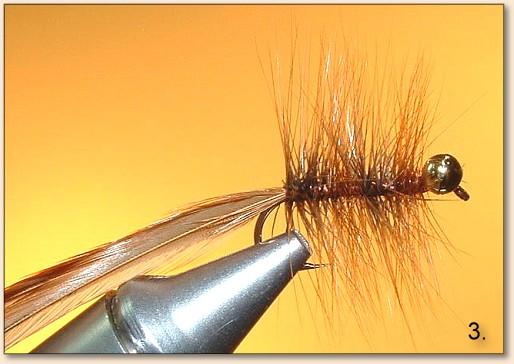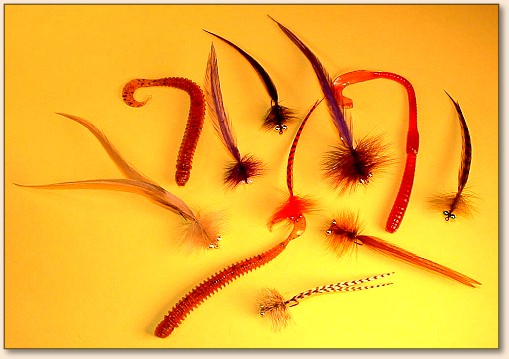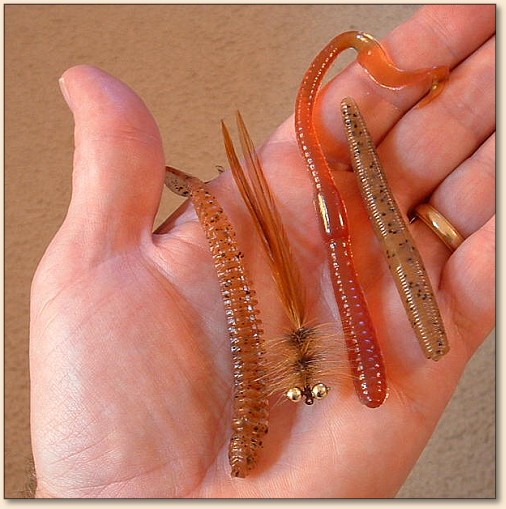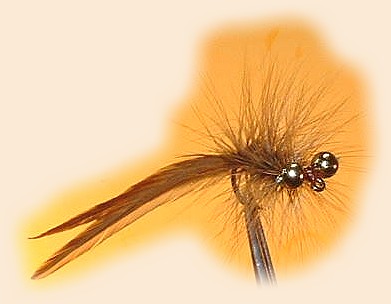Hard-Hackle Worm
By Richard Komar
A worm is an animal with a soft, slender body and no
backbone or legs. There are thousands of species of
worms, the largest measure several feet long and the
smallest ones can't be seen without a microscope! Some
worms live in water or soil. There are four main groups
of worms: flatworms, ribbon worms, roundworms and segmented
worms. Segmented worms, which include leeches and earthworms,
are of most interest to flyfishers.
Flyfishers are always looking for a lightweight imitation
of the earthworm, so allow me to introduce another member
of my Hard-Hackle family: the Hard-Hackle Worm!
Materials List: Hard-Hackle Worm
Hook: Mustad 94840, or Equivalent, sizes 6, 2, or 1/0.
Thread: 6/0 or 8/0 Brown
Body: Rooster Cape Feather, Brown or furnace.
Tail: Rooster Saddle Feather, Brown or furnace.
Eyes: Plastic Christmas Tree Garland, gold color.
Tying the Hard-Hackle Worm

1. Lay a smooth thread base along the hook shank
starting from the hook eye, wrapping toward the hook
bend and attach two saddle feathers, one on top of
each other, concave side (dull) down. For a size 6 worm,
make the overall length 3 inches; for a size 2 or 1/0 bass
worm, make the total length 5 inches.

2. Select a rooster cape feather and tie it in
at the hook bend, concave side (dull) facing the
hook eye. Wrap the hackle densely toward the eye.
You will need to attach a second hackle midway to
densely wrap the entire shank.

3. Tie in a pair of plastic bead eyes near the
hook eye with a figure 8 wrap, whip finish and
apply head cement. Done!
How to Fish the Hard-Hackle Worm:

-
The Hard-Hackle Worm is virtually weightless and with its
streamlined, earthworm shape, aerodynamic as well. The
eyes are plastic so as not to give the worm a "head-down"
feeding posture, but rather a free-swimming form which
gives it plenty of body action to entice fish.
-
The Hard-Hackle Worm is fished on the surface first
and it imitates a small snake at this stage. When
the hackles become waterlogged, or the flyfisher tugs
the Worm, it will slowly sink. The Worm is fished very,
very slowly, with occasional short twitches. You can
attach a monofilament weed guard if you will be fishing
weedy, grassy areas. The Worm is most effective along
shorelines and edges of hydrilla and lily pads.
-
I have caught bluegills, largemouth bass and even catfish
(my largest was 21" inches and very mean). Tie the
Hard-Hackle Worm in a variety of colors and don't
forget to share them with your fellow flyfishers. Have fun.

~ Richard
About Richard:
Richard Komar resides in Plano and flyfishes the warm
waters of north Texas from his folding boat. He is a
member of the Dallas FlyFishers and the Federation of
Fly Fishers.
|



